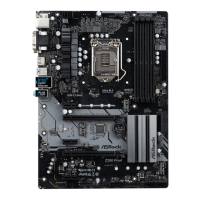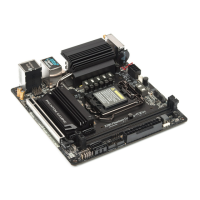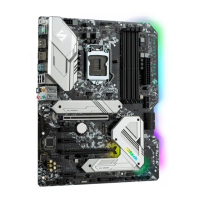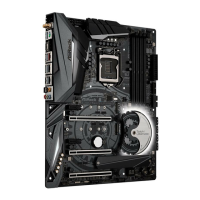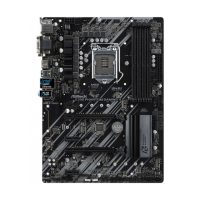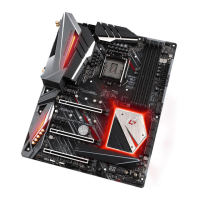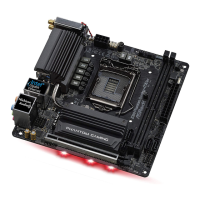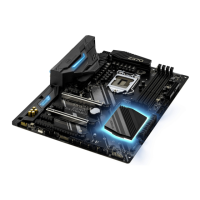Do you have a question about the ASROCK Z390 Extreme4 and is the answer not in the manual?
Lists all items included in the motherboard package for user reference and setup.
Details the technical specifications of the motherboard, including CPU, memory, expansion slots, graphics, and audio capabilities.
Provides a visual diagram and numbered list identifying key components and connectors on the motherboard.
Describes the rear panel connectors and their functions for external device connectivity.
Outlines essential safety and handling procedures to prevent damage before installing components or changing settings.
Step-by-step guide for correctly installing the CPU into the motherboard socket, including visual aids.
Instructions on how to mount the CPU cooling fan and heatsink assembly onto the motherboard.
Guide for correctly inserting DDR4 DIMM modules into the motherboard slots for dual-channel memory configuration.
Explains the types and configurations of PCI Express slots for graphics cards and other expansion devices.
Details the function and setup of motherboard jumpers, specifically the Clear CMOS jumper.
Describes the various internal headers and connectors on the motherboard for case buttons, LEDs, and peripherals.
Instructions for installing and configuring NVIDIA SLI and Quad SLI for multi-GPU setups, including driver setup.
Guide for installing and configuring AMD CrossFireX for multi-GPU setups, including driver setup.
Step-by-step instructions for installing M.2 WiFi/BT or Intel CNVi modules into the motherboard's M.2 E-key slot.
Detailed guide on how to install M.2 SSD modules into the motherboard's M.2 slots, including nut locations.
Explains how to install necessary drivers and utilities from the support CD for optimal motherboard functionality.
Introduces ASRock's A-Tuning software for system monitoring, overclocking, and fan control.
Describes the ASRock Live Update & APP Shop for downloading software, drivers, and keeping the system updated.
Guide on connecting and customizing RGB LED lighting effects using the ASRock Polychrome RGB utility.
Explains how to enter and navigate the UEFI BIOS setup utility for system configuration.
Provides an overview of the EZ Mode BIOS screen, showing crucial system status information and basic options.
Details the Advanced Mode of the UEFI BIOS, including menu bar options, navigation keys, and general settings.
Displays the main UEFI screen, showing system information and allowing access to favorite BIOS items.
Explains how to use the OC Tweaker screen for system overclocking configurations, including CPU and GPU settings.
Covers detailed system configurations within the Advanced screen, such as CPU, Chipset, Storage, and more.
Details various CPU settings within the BIOS, including Hyper Threading, C-states, and thermal throttling.
Explains how to configure chipset-related settings, including graphics adapter, PCIe link speeds, and onboard devices.
Describes settings for SATA controllers, RAID modes, and hard disk monitoring technologies like S.M.A.R.T.
Covers settings for enabling and configuring Intel Thunderbolt support, including boot and security options.
Details settings for legacy hardware ports like Serial Ports and PS/2 devices managed by the Super IO controller.
Explains ACPI settings for power management, sleep states, and wake-up events for various system components.
Covers settings for USB support, including legacy USB support and XHCI hand-off for different operating systems.
Details settings related to Trusted Platform Module (TPM) support and security device enablement.
Describes the various utility tools available in the BIOS for system maintenance and firmware updates.
Explains how to monitor system hardware status, including temperatures, fan speeds, and voltages.
Covers settings for system security, including supervisor/user passwords, secure boot, and platform trust technology.
Details options for configuring boot settings, boot priority, fast boot, and compatibility support modules.
Describes the options available on the Exit screen for saving changes, discarding changes, and loading defaults.
Lists all items included in the motherboard package for user reference and setup.
Details the technical specifications of the motherboard, including CPU, memory, expansion slots, graphics, and audio capabilities.
Provides a visual diagram and numbered list identifying key components and connectors on the motherboard.
Describes the rear panel connectors and their functions for external device connectivity.
Outlines essential safety and handling procedures to prevent damage before installing components or changing settings.
Step-by-step guide for correctly installing the CPU into the motherboard socket, including visual aids.
Instructions on how to mount the CPU cooling fan and heatsink assembly onto the motherboard.
Guide for correctly inserting DDR4 DIMM modules into the motherboard slots for dual-channel memory configuration.
Explains the types and configurations of PCI Express slots for graphics cards and other expansion devices.
Details the function and setup of motherboard jumpers, specifically the Clear CMOS jumper.
Describes the various internal headers and connectors on the motherboard for case buttons, LEDs, and peripherals.
Instructions for installing and configuring NVIDIA SLI and Quad SLI for multi-GPU setups, including driver setup.
Guide for installing and configuring AMD CrossFireX for multi-GPU setups, including driver setup.
Step-by-step instructions for installing M.2 WiFi/BT or Intel CNVi modules into the motherboard's M.2 E-key slot.
Detailed guide on how to install M.2 SSD modules into the motherboard's M.2 slots, including nut locations.
Explains how to install necessary drivers and utilities from the support CD for optimal motherboard functionality.
Introduces ASRock's A-Tuning software for system monitoring, overclocking, and fan control.
Describes the ASRock Live Update & APP Shop for downloading software, drivers, and keeping the system updated.
Guide on connecting and customizing RGB LED lighting effects using the ASRock Polychrome RGB utility.
Explains how to enter and navigate the UEFI BIOS setup utility for system configuration.
Provides an overview of the EZ Mode BIOS screen, showing crucial system status information and basic options.
Details the Advanced Mode of the UEFI BIOS, including menu bar options, navigation keys, and general settings.
Displays the main UEFI screen, showing system information and allowing access to favorite BIOS items.
Explains how to use the OC Tweaker screen for system overclocking configurations, including CPU and GPU settings.
Covers detailed system configurations within the Advanced screen, such as CPU, Chipset, Storage, and more.
Details various CPU settings within the BIOS, including Hyper Threading, C-states, and thermal throttling.
Explains how to configure chipset-related settings, including graphics adapter, PCIe link speeds, and onboard devices.
Describes settings for SATA controllers, RAID modes, and hard disk monitoring technologies like S.M.A.R.T.
Covers settings for enabling and configuring Intel Thunderbolt support, including boot and security options.
Details settings for legacy hardware ports like Serial Ports and PS/2 devices managed by the Super IO controller.
Explains ACPI settings for power management, sleep states, and wake-up events for various system components.
Covers settings for USB support, including legacy USB support and XHCI hand-off for different operating systems.
Details settings related to Trusted Platform Module (TPM) support and security device enablement.
Describes the various utility tools available in the BIOS for system maintenance and firmware updates.
Explains how to monitor system hardware status, including temperatures, fan speeds, and voltages.
Covers settings for system security, including supervisor/user passwords, secure boot, and platform trust technology.
Details options for configuring boot settings, boot priority, fast boot, and compatibility support modules.
Describes the options available on the Exit screen for saving changes, discarding changes, and loading defaults.
| ECC | Yes |
|---|---|
| Memory channels | Dual-channel |
| Memory slots type | DIMM |
| Number of memory slots | 4 |
| Supported memory types | DDR4-SDRAM |
| Maximum internal memory | 64 GB |
| Supported memory clock speeds | 2133, 2400, 2666, 2800, 2933, 3200, 3600, 3733, 3800, 3866, 4000, 4133, 4266, 4300 MHz |
| Processor socket | LGA 1151 (Socket H4) |
| Processor manufacturer | Intel |
| Compatible processor series | Intel Core i3, Intel Core i5, Intel Core i7, Intel Core i9 |
| USB 2.0 connectors | 2 |
| Number of COM connectors | 1 |
| Number of SATA III connectors | 8 |
| USB 3.2 Gen 1 (3.1 Gen 1) connectors | 3 |
| USB 3.2 Gen 2 (3.1 Gen 2) connectors | 0 |
| DisplayPort version | 1.2 |
| USB 2.0 ports quantity | USB 2.0 ports have a data transmission speed of 480 Mbps, and are backwards compatible with USB 1.1 ports. You can connect all kinds of peripheral devices to them. |
| Audio chip | Realtek ALC1220 |
| Certification | FCC, CE, ErP/EuP |
| Component for | PC |
| Motherboard chipset | Intel Z390 |
| PC health monitoring | CPU, FAN, Temperature, Voltage |
| Audio output channels | 7.1 channels |
| Motherboard form factor | ATX |
| Windows operating systems supported | Windows 10 Education x64, Windows 10 Enterprise x64, Windows 10 Home x64, Windows 10 Pro x64 |
| BIOS type | UEFI AMI |
| ACPI version | 6.0 |
| BIOS memory size | 256 Mbit |
| System Management BIOS (SMBIOS) version | 2.7 |
| DirectX version | 12.0 |
| Maximum resolution | 4096 x 2160 pixels |
| Parallel processing technology support | 3-Way CrossFireX, CrossFireX, NVLink, Quad-GPU CrossFireX, Quad-GPU SLI, SLI |
| LAN controller | Intel® I219-V |
| Ethernet interface type | Gigabit Ethernet |
| Cables included | SATA |
| Bundled software | ASRock A-Tuning, ASRock Polychrome RGB, ASRock XFast LAN |
| RAID levels | 0, 1, 5, 10 |
| Harmonized System (HS) code | 84733020 |
| Depth | 244 mm |
|---|---|
| Width | 305 mm |
